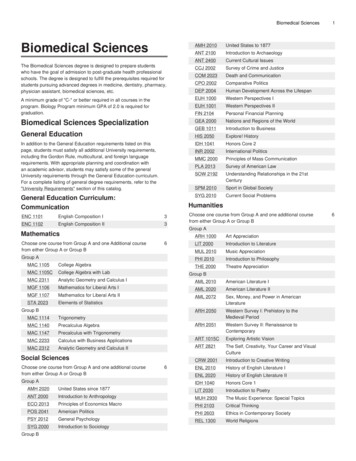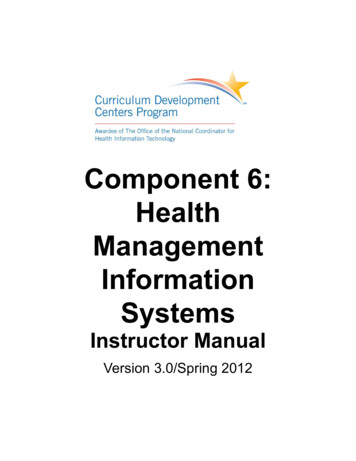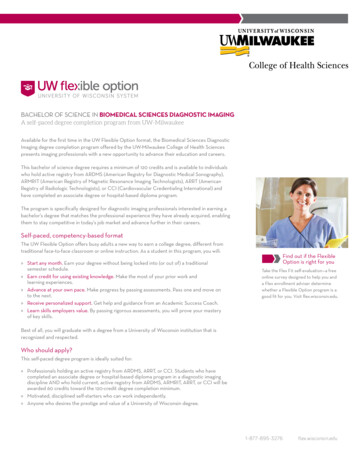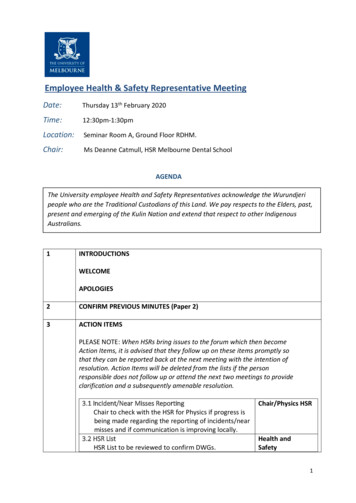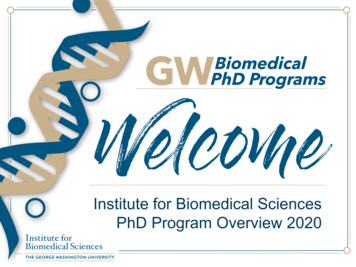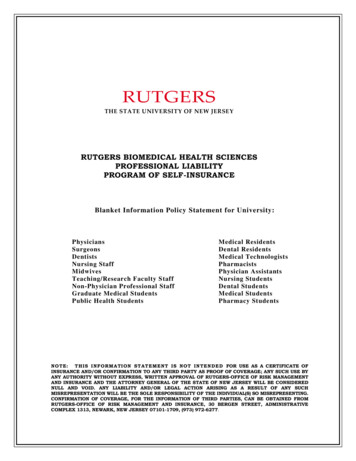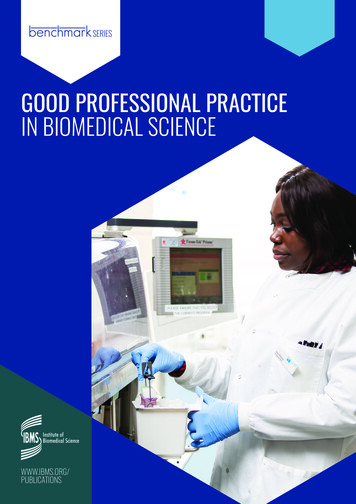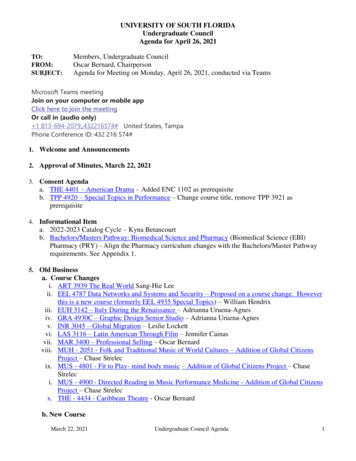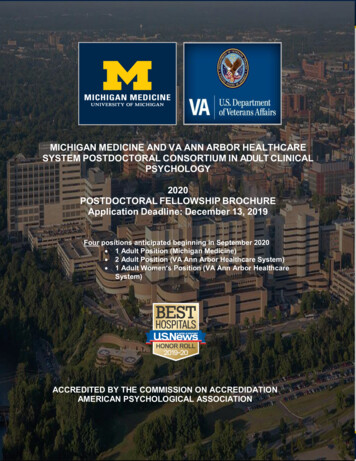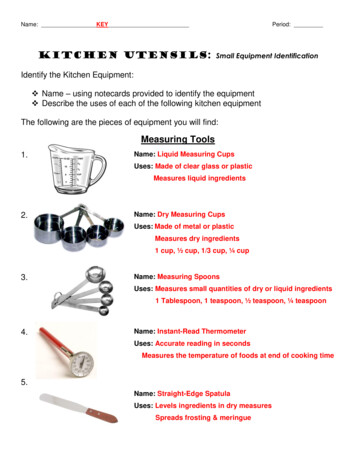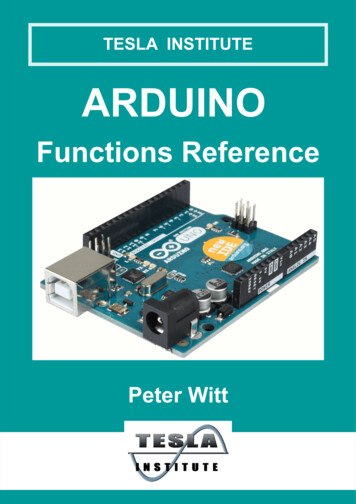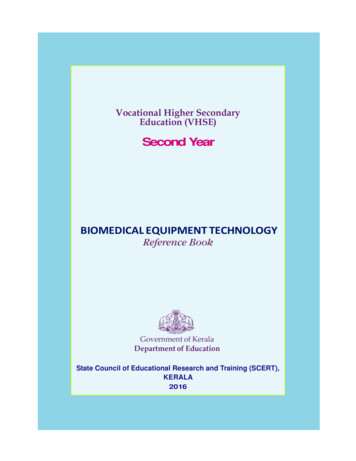
Transcription
Vocational Higher SecondaryEducation (VHSE)Second YearBIOMEDICAL EQUIPMENT TECHNOLOGYReference BookGovernment of KeralaDepartment of EducationState Council of Educational Research and Training (SCERT),KERALA2016
Reference BookLIST OF CONTRIBUTORSParticipants:1.Mini Kumary.C.K, Principal (Vocational Teacher in MOBE),HCHMKMVHSS, Vallakkadavu,TVPM.2.John Varghese, Principal (Vocational Teacher in MOBE),VHSS, Muthukulam.3.Ajadevi.S, Vocational Teacher in MOBE,Madathil VHSS, Kollam4.Suresh Kumar.G, Vocational Teacher in MOBE,RVHSS, Valakom, Kollam.5.Siny.S, Vocational Teacher in MOBE),VHSS, Muthukulam.Subject experts6.Vijayakumar.K, Former HOD,Biomedical Engineering Department,Sree Chitra Thirunal Institute of Medical Sciences andTechnology(SCTIMST),TVPM.7.Sharafudeen. S, Biomedical Engineer,BSc.MLT Block,Govt. Medical College, TVPM.Academic Co - ordinatorDr. A. Safeerudeen, R. O, SCERTPrepared by :State Council of Educational Research and Training(SCERT)Poojappura, Thiruvananthapuram 695012, KeralaWebsite : www.scertkerala.gov.in e-mail : scertkerala@gmail.comPhone : 0471 - 2341883, Fax : 0471 - 2341869Typesetting and Layout : SCERT Department of Education, Government of Kerala2
BIOMEDICAL EQUIPMENT TECHNOLOGYForewordDear Learners,This book is intended to serve as a ready reference for learners ofvocational higher secondary schools. It offers suggested guidelinesfor the transaction of the concepts highlighted in the course content.It is expected that the learners achieve significant learning outcomesat the end of the course as envisaged in the curriculum if it is followedproperly.In the context of the Right- based approach, quality education has tobe ensured for all learners. The learner community of Vocational HigherSecondary Education in Kerala should be empowered by providingthem with the best education that strengthens their competences tobecome innovative entrepreneurs who contribute to the knowledgesociety. The change of course names, modular approach adopted forthe organisation of course content, work-based pedagogy and theoutcome focused assessment approach paved the way for achievingthe vision of Vocational Higher Secondary Education in Kerala. Therevised curriculum helps to equip the learners with multiple skillsmatching technological advancements and to produce skilledworkforce for meeting the demands of the emerging industries andservice sectors with national and global orientation. The revisedcurriculum attempts to enhance knowledge, skills and attitudes bygiving higher priority and space for the learners to make discussionsin small groups, and activities requiring hands-on experience.The SCERT appreciates the hard work and sincere co-operation ofthe contributors of this book that includes subject experts, industrialistsand the teachers of Vocational Higher Secondary Schools. Thedevelopment of this reference book has been a joint venture of theState Council of Educational Research and Training (SCERT) andthe Directorate of Vocational Higher Secondary Education.The SCERT welcomes constructive criticism and creative suggestionsfor the improvement of the book.With regards,Dr. P. A. FathimaDirectorSCERT, Kerala3
Reference BookSl No4ContentPage No1.About the Course52.Major skills (with sub skill )53.Syllabus74.Surgical/Analytical & TherapeuticEquipment Overview of Module 375.Unit 1: Operation Theatre Equipment116.Unit 2 : Central Sterile Supply Department (Cssd)187.Unit 3 : Central Medical Gas Distribution System288.Unit4 : Laboratory And Blood Bank Instruments349.Unit5: Dialysis Equipment5410.Unit 6: Therapeutic Equipments5811.Unit 7: Biomedical Waste Management6212.Unit 8: Audiometry6613.Unit 9: Major Equipments In Other Departments6914.Medical Imaging Overview Of Module 47615.Unit 1: Radiography7616.Unit2 : Ultrasonography8517.Unit 3 - Modern Equipment In Medical Imaging8918.Unit 4 - Patient Safety9219.List Of References99
BIOMEDICAL EQUIPMENT TECHNOLOGYABOUT THE COURSEA variety of electrical and electronic equipment are used in hospitals for variousdiagnostic and therapeutic purposes; including operation theatre and also used foranesthesia and surgical purposes. Modern medicine is emerging in new trend inequipment technology. The success of the procedures and safety of patient dependslargely on the reliability, precision sensitivity and trouble free performance of theseequipment. It is also necessary that Biomedical equipment used in hospitals anddiagonostic centres should be standardized by callibrating in time. For this, we needqualified and skilled technicians. But skilled hands are very less in this sector. Due tothe lack of these technicians Biomedical equipments remain in un operationalcondition without adequate maintenance support especially in govt sector. So thiscourse can fill this lacunae providing trained manpower in almost all branches ofmodern medicine like Cardiology, Nuerology,Physical Medicine, Medical imaging,CSSD,Dialysis room,Manifold, etc. They can get vertical mobility in all thesedisciplines in medical field. This will lead to better service to the mankind aiming atbetter healthcare management.BET COURSE - MAJOR SKILLSThis course offers therapeutic/ analytical and surgical equipment in module 3 andmedical imaging equipment in module 4. Understand Production, properties and applications of X-rays, absorption ofX-rays, unit of X-ray the principle of radiography, Identify the block diagram of X-ray machine , types of X-ray machine, unit ofX rays- Mobile, stationary, OPG, C arm, mammography, digital X-ray. X-rayfilm- Construction- processing and digital processing. AERB regulations andgeneral safety in radiography, Effect of X-ray in human body. Familiarize and identify operation theater equipment like OT lights, OTtables,Anesthesia equipment, Elecrto surgical unit, and other OT equipments Aims and objectives of CSSD, workflow in CSSD, concept of sterilization definition and importance of sterilization, classification and methods of sterilization, equipment used for sterilization and their uses, autoclave , hot air oven.Equipment safety and sterilization controls (chemical and biological controls),and introduction to liquid oxygen supply. Identify and understand Microscopy - different types of microscopes, working principle, parts, magnification, adjustments, maintenance and uses of a compound microscope Identify and understand photoelectric colorimeter - working principle, parts,block diagram, procedure, maintenance and applications, introduction toglucometers.5
Reference Book " 6Identify and understand - PHmeter- working principle, parts, block diagram,procedure, maintenance and applications, Clinical relevance of blood PH,Importance of general safety in hospitals, the effects of electricity on humanbody, electric shock hazards and precautions to avoid shock, IEC documentand safety codes of biomedical equipment, grounding in Biomedical Equipment, familiarize Rules and Ethics in medical field.Familiarize and identify - Centrifuge- parts, working, maintenance of table topcentrifuge, Fundamentals of Eletrolyte analyser, Blood gas analyser, incubatorand waterbath , Familiarise Automatic Hemoanalysers and blood cell counters,General safety, equipment safety and Quality Control in Medical laboratories,name and uses of Blood bank equipments-Blood bank refrigerators, Blod bankcentrifuges, cryo centrifuge,cry bath, deep freezers,Apheresis machines, donor couch, blood bag sealer, platelet agitator, blood shaker.Familiarize and identify - concept of central medical gas supply system, basiccomponents, manifold, suction apparatus - parts, working and uses, introduction to pendant for gas supply, safety and precautions in manifold and pipelinesupply.Familiarize dialysis - Importance of dialysis, Types of dialysis - peritonealdialysis and hemo dialysis, Hemodialysis - fundamentals and applicationsEnlist therapeutic equipments- Radiotherapy , physiotherapy ,phototherapy,magneto therapy equipment. Radiotherapy Equipment Physiotherapy equipment - Short wave diathermy, microwave diathermy, ultrasound diathermy, nerve and muscle stimulators, TENS, IFT, IR lamps,CPRM,Familiarize biomedical waste management - definition and classification ofbiomedical waste., steps in waste management, segregation, collection, storage, transportation, disposal - equipment used, autoclave, incinerator, safetyaspects regarding biomedical waste.Enlist Fiber optic equipment in medicine and equipment in an ICU,Familiarize Enginering services, civil engineering, mechanical work shop, Electrical.Understand ultra sound physics, principle of oscillation, circuit diagram- working of crystal oscillator, fundamentals of ultra sonography, medical applicationsof ultra sonographyFamiliarize fundamentals of CT scanning, Fundamentals of MRI scanning.Familiarization of modern imaging techniques- names only, Applications of PET,SPECT, gamma camera.
BIOMEDICAL EQUIPMENT TECHNOLOGYSYLLABUSMODULE 3Surgical/Analytical and Therapeutic EquipmentUNIT 1: OPERATION THEATRE EQUIPMENTBasic fundamentals of operation theatre, List of OT equipment and its applications(OT tables, OT lights, Anesthesia machines, Anesthesia ventilators, multi para monitor,ESU, central suction, heart lung machine - names and uses only), Characteristics,classification, types of OT table (mechanical, pneumatic and electrical) and light(Lux, voltage and wattage), fundamentals of Anesthesia, parts of anesthesia machineand applications, principle of surgical diathermy, different electrodes used in surgicaldiathermy, different modes of operation in surgical diathermy (electrotomy,coagulation, fulguration, desiccation), block diagram and description of ESU,applications of ESU, safety in OT - general guidelines, equipment safety - ESU andanesthesia machines, concept of modular OT.UNIT 2 : CENTRAL STERILE SUPPLY DEPARTMENT (CSSD)Aims and objectives of CSSD, workflow in CSSD, concept of sterilization defini9sion and importance of sterilization, classification and methods of sterilization,equipment used for sterilization and their uses, autoclave - working principle - parts,procedure, maintenance and uses, hot air oven - parts, procedure, maintenanceand uses. Equipment safety and sterilization controls (chemical and biological controls),introduction to liquid oxygen supply.UNIT 3 : CENTRAL MEDICAL GAS DISTRIBUTION SYSTEMIntroduction to concept of central medical gas supply system, basic components,manifold, suction apparatus - parts, working and uses, introduction to pendant forgas supply, safety and precautions in manifold and pipeline supply.UNIT4 : LABORATORY AND BLOOD BANK INSTRUMENTSMicroscopy - introduction , different types of microscopes, working principle, parts,magnification, adjustments, maintenance and uses of a compound microscope,photoelectric colorimeter - working principle, parts, block diagram, procedure,maintenance and applications, introduction to glucometers. PHmeter- workingprinciple, parts, block diagram, procedure, maintenance and applications, Clinicalrelevance of blood PH, Centrifuge- parts, working, maintenance of table topcentrifuge, Fundamentals of Eletrolyte analyser, Blood gas analyser, incubator and7
Reference Bookwaterbath , Familiarise Automatic Hemoanalysers and blood cell counters, Generalsafety, equipment safety and Quality Control in Medical laboratories, name anduses of Blood bank equipments-Blood bank refrigerators, Blod bank centrifuges,cryo centrifuge,cry bath, deep freezers,Apheresis machines, donor couch, bloodbag sealer, platelet agitator, blood shaker.UNIT5: DIALYSIS EQUIPMENTIntroduction to dialysis - Importance of dialysis, Types of dialysis - peritoneal dialysisand hemo dialysis, Hemodialysis - fundamentals and applicationsUNIT 6: THERAPEUTIC EQUIPMENTSIntroduction to types of therapeutic equipments- Radiotherapy , physiotherapy,phototherapy, magneto therapy equipment. Radiotherapy Equipment Physiotherapy equipment - Short wave diathermy, microwave diathermy, ultrasounddiathermy, nerve and muscle stimulators, TENS, IFT, IR lamps, CPRM, (namesand uses only is required)UNIT 7: BIOMEDICAL WASTE MANAGEMENTIntroduction to biomedical waste management - definition and classification ofbiomedical waste., steps in waste management, segregation, collection, storage,transportation, disposal - equipment used, autoclave, incinerator, safety aspectsregarding biomedical waste.UNIT 8: AUDIOMETRYAnatomy of ear and mechanism of hearing. Types of audiometers - Pure toneaudiometer and speech audiometer, the parts and operation of pure tone audiometer,the types and uses of hearing aids.UNIT 9: FIBER OPTICS IN MEDICINE, (List of equipmentand its uses), laser and its uses, Engineering service - civilengineering, medical, electrical.Fiber optics in medicine(List out equipment and its uses) ,civil engineering - water supply, mechanical work shop, air conditioning, electrical.8
BIOMEDICAL EQUIPMENT TECHNOLOGYMODULE 4Medical ImagingUNIT1: RADIOGRAPHYProduction, properties and applications of X-rays, absorption of X-rays, unit of Xray the principle of radiography, block diagram of X-ray machine , types of X-raymachine, unit of X rays- Mobile, stationary, OPG, C arm, mammography, digital Xray. X-ray film- Construction- processing and digital processing. AERB regulationsand general safety in radiography, Effect of X-ray in human body.UNIT2 : ULTRASONOGRAPHYTo understand ultra sound physics, principle of oscillation, circuit diagram- workingof crystal oscillator, fundamentals of ultra sonography, medical applications of ultrasonographyUnit 3 - MODERN EQUIPMENT IN MEDICAL IMAGINGFundamentals of CT scanning, Fundamentals of MRI scanning. Familiarization ofmodern imaging techniques- names only, Applications of PET, SPECT, gammacamera.Unit 4 - PATIENT SAFETYImportance of general safety in hospitals, the effects of electricity on human body,electric shock hazards and precautions to avoid shock, IEC document and safetycodes of biomedical equipment, grounding in Biomedical Equipment, familiarizeRules and Ethics in medical field.9
Reference BookPART BOVERVIEW OF MODULE 3SURGICAL/ANALYTICAL &THERAPEUTIC EQUIPMENTThis module includes different surgical , analytical and therapeutic equipment used inmedical field. As a beginner in biomedical equipment technology, a learner can beexposed to all these equipment. In unit 1 , general surgical equipment like OT table,OT lights, surgical diathermy, anesthesia machines, anesthesia ventilators , and electrosurgical unit are included .Importance of sterilization in a hospital environment , Types of sterilization ,Equipmentits applications, sterile materials and its supply is given in unit 2.Central medical gas distribution system is given as third unit, It includes types ofmedical gases, storage and supply through pipeline system. Suction apparatus itsworking and application is also included in this unit.Unit 4 include laboratory and blood bank instruments. Here in this module we coverMicroscopy, Maintenance, parts, uses and working of Photo electric colorimeter,PH meter, Basic idea of Electrolyte analyzer, blood gas analyser, incubator andwaterbath. Biochemical and hematology auto analyzers are also included.Introduction to blood cell counters and blood bank equipment is also given.Hemodialysis equipment, radiotherapy equipment, physiotherapy equipment, areintroduced. An important department in medical field included is Biomedical wastemanagement. As a person working in a hospital environment one should understandthe importance of Biomedical waste management. Fundamentals of collection,segregation, processing only is given.An introduction to fiberoptic instruments,equipment in an ICU, civil, mechanicaland electrical departments is given for familiarization for the learner. Hospital computerapplications and and importance of hospital information system is also included.10
BIOMEDICAL EQUIPMENT TECHNOLOGYUnit 1Operation Theatre EquipmentIntroductionOperation theatre is a space for surgical procedures in a hospital. It consists of apreparatory area, pre surgical area and a procedure area. The procedure area is anabsolutely sterile area for during the surgery. All surgical equipment is kept in thisarea.OT tables, OT lights, anesthesia cart, ESU, all other surgical tools are kept inthis area. Details of principle, parts, working and applications of ESU is alsoincluded in the syllabus.Learning OutcomeUpon completion of unit, the learner will be able to:-3.1.1Basic fundamentals of operation theatre.3.1.2List of OT equipments and its applications.3.1.3Familiarise OT table and light.3.1.4Familiarise fundamentals of anesthesia, parts ofanesthesia machine.3.1.5Understand the principles of diathermy.3.1.6Familiarise different electrodes used in surgicaldiathermy.3.1.7Familiarise different modes of operation in surgicaldiathermy.3.1.8Identify the block diagram and description of ESU.3.1.9Identify the applications of ESU.3.1.10Identify the general safety aspects and equipmentsafety in OT.Basic fundamentals of operation theatreAn operating theater is a facility within a hospital where surgical operations arecarried out in a sterile environment. Operating rooms are spacious, easy to clean,and well-lighted. Operating rooms consist of overhead surgical lights, operationtable and may have equipment, viewing screens and monitors. Rooms are suppliedwith wall suction, oxygen, and possibly other anesthetic gases. There is storagespace for common surgical supplies.11
Reference BookOperation theatres are designed as per the requirements of the hospital like numberof beds, types of surgical procedures, number of surgeons, number of surgery perday etc.The operation theatre have mainly four zones - protective zone, clean zone, sterilezone and disposal zone.Protective zone - reception, waiting for patients, changing room, pre- anesthesiaroom, store room, autoclave room ,control room for electricity.etc.Clean zone - pre-operating room, recovery room, plaster room, x-ray unit, staffroom, anesthesia storeSterile zone - operating room, scrub room, aesthesia room, instrument trolley area,instant sterilization unit.etc.Disposal room - disposal corridors, dirty wash up room.An operation theatre should be supplied with uninterrupted power supply, airconditioning and ventilation. Manifold facilities, service pendant provisions shouldbe made. Fixed service pendent are usually available with oxygen, compressed airand vacuum outlet. High efficiency HEPA filters provide clean and sterile air inoperating rooms. Maintenance of OT aseptic standards is very much important tominimize hospital acquired infections.The significance of location, grouping and size has a role to play in planning OT.Aproperly staffed , equipped and organized OT along with well framed policies andprocedures ,functions with high standards of efficiency.List of OT equipment and its applications.1.Operating table2.Anesthesia machine3.Anesthesia cart4.Ventilator5.Multiparameter monitor6.Central suction7.Heart-lung machine8.Defibrillator9.ESU10. Pulse oximeter12
BIOMEDICAL EQUIPMENT TECHNOLOGYApplications OT equipment1.The anesthesia machine - Minimize anaesthesia related risk to patient and staff.2. The anesthesia cart - It contains the medications, equipment, and other supplies that the anesthesiologist may need.3.Multipara monitor- Records the BP, ECG, heart rate and oxygen saturation4.The pulse oximeter machine- Measures the amount of oxygen contained in theblood.5.Automated blood pressure measuring machine- Measures BP automatically.6.Heart-lung machine takes the temporary control of the heart and lung duringthe surgery maintaining the circulation of blood and oxygen content of the bodyOT tableThe operating table is a table on which a patient is placed during a surgical operation.Stationary operating table system is firmly anchored to the floor. So the additionalnecessary medical devices can easily be brought to the operating area and positioned.The advantage of the mobile operating table, on the other hand, is that the positionof the table can be changed within the operating room. However, the foot of thetable limits the leg space available to the surgical team.Another special feature of the operating table system is the ability to establishcommunication with diagnostics systems. (Angiography, MRI and CT etc). This isonly possible with stationary columns.Surgical lights provide lighting in surgical suites to illuminate the surgical site foroptimal visualization without shadows during surgery.Types of lamps include tungsten, quartz, and/or xenon halogens and light-emittingdiodes. Advantages of LED is less heat, longer life, better energy efficiency, purewhite colour,more colour rendition, improved shadow control.The Halogen Operation Lights are designed to assists during critical operations wherefocused source of bright light is required.Familiarize fundamentals of anesthesiaWhen anaethesia is given, the patient loses consciousness. The usual method ofanaethesia is inhalation anaethesia. The most widely used anesthetic gases arehalogenated ethers such as enflurane, halothane, isoflurane, and desflurane coupledwith nitrous oxide. During anaethesia, required amount of oxygen is also supplied to13
Reference Bookthe patient. In critical stage it is necessary to support the patient with controlledventilation also.Four essential functions are1.Provides oxygen2.Mix anesthetic gas with vapours3.Enable patient ventilation4.Minimise anaesthesia related risk to patient and staff14
BIOMEDICAL EQUIPMENT TECHNOLOGYPrinciples of diathermyWhen a high frequency current is applied totissue, the tissue is heated locally. Thisproperty can be used to cut, coagulate,fulgurate and desiccate tissue. The frequencyof current used in surgical diathermy is in therange 1-3 MHzWhen the intracellular temperature reaches60 degrees C, instantaneous cell deathoccurs. If tissue is heated to 60-99 degreesC, tissue desiccation (dehydration) occurs.If the intracellular temperature rapidly reaches100 degrees C, desiccation and coagulationoccur which prevent bleeding.Different electrodes used insurgical diathermyThere are two configuration of using surgicaldiathermy electrode. They are 1. Monopolarconfiguration 2 Bipolar configurationIn monopolar configuration the patient is attached to an electrode called dispersiveelectrode, a relatively large metal plate. The surgeon uses a pointed or blade shapedelectrode called the "active electrode" to make contact with the tissue.With "bipolar" instruments the current is applied to the patient using a pair of similarlysized electrodes.Different electrodesa. Lancet electrodes - For cutting application.b. Needle electrodes - For epilation and desiccationc. Ball type electrode - For coagulationd. Loop electrodes - For opening up channels and extirpating growth.Familiarize different modes of operation in surgical diathermy.Cutting mode: Electrode touches the tissue. When this HF current passes throughthe sharp edge of diathermy electrode, there is a high concentration of current at thispoint and heat is produced. Sufficiently high power current is applied to the tissue.15
Reference BookBy increasing current level deeper level cutting take place. Normally continuous RFwaveis used for cutting.Coagulating mode: when the system is operating in "coag mode" the voltage outputis usually lower than cutting mode and less power is delivered. Therefore, thisgenerates less heat. Tissue remains grossly unharmed, but cells are destroyed at thepoint of contact. Smaller vessels are destroyed and sealed, stopping bleeding.Desiccation: is the process making of extreme dryness. The amount of generatedheat is lower than that required for cutting. Needle point electrode is used here.Fulguration mode: In this the superficial tissue is destructed without affecting deepseated tissue. The electrode is held near the tissue without touching it. An electricarc is developed between the electrode and tissue, which heat dries out the tissue.Haemostasis mode: The simultaneous use of continuous RF wave for cutting andburst of RF wave for coagulation is called haemostasis mode.Identify the applications of ESU.Identify the general safety aspects and equipment safety in OTThe general safety aspects of ESU fall into four main categories1.Burns2.High frequency current hazard. Electrical interference with the heart muscles(ventricular fibrillation)3.Explosion hazards1. BurnsA major hazard associated with ESU is burns caused by excess current flow. Theburn occurs at the dispersive electrode because of failure to achieve active adequatecontact. In a later case, injury occurs at a point where the patient is unintentionallytouching a ground object and contact is made over a small area of skin.The risk of burns also occurs due to the presence of moisture ie the accumulationblood or other fluids around the indifferent electrode can give rise to small, highlyconductive area. Burns resulting from small conductive area between the limbs canbe prevented by means of dry cloth placed between them.2. High frequency current hazard3. Explosion hazardsThe spark associated with surgical diathermy can cause a dangerous explosion ifexplosives such as ether, alcohol and explosives anaethetic gases are not kept awayfrom ESU.16
BIOMEDICAL EQUIPMENT TECHNOLOGYThe use of non explosive gases such as nitrous oxides, fluothane or halothane isrecommended to prevent such shock hazards. It is also important to kept away,ESUfrom all flammable gases.Details of practicalsOT :1.Operation theatre equipment : Collection of details using internet and preparing charts.2.Field Visit to operation theatre3.Preparation of vocational album using operation theatre lights, table, electrosurgical unit.Sample questions1.List out the different modes of operation in surgical diathermy2.List out any five equipment used in operation theatre.3.Draw the block diagram of ESU4.write the safety precautions to be taken in using ESU.5.The frequency off AC usually used in ESU is ----------------17
Reference BookUnit: 2Central Sterile Supply Departments CSSDIntroductionThis unit deals with the processes donein the CSSD , Aims and objectives ofCSSD, work flow in a CSSD,Importance of sterilization in a hospital,methods of sterilization, equipments usedfor sterilization ,their working, parts, andapplications.The central sterile supply department(CSSD) is an important facility of ahospital which ensures a high standardof sterilization and disinfection to minimize hospital acquired infections. CSSD servicesare responsible for receiving, processing, storing, issue and control of professionalsupply of instruments, equipments and surgicals.SYLLABUSAims and objectives of CSSD, workflow in CSSD, concept of sterilization defini9sion and importance of sterilization, classification and methods of sterilization,equipment used for sterilization and their uses, autoclave - working principle - parts,procedure, maintenance and uses, hot air oven - parts, procedure, maintenanceand uses. ETO sterilization , Flash sterilizers, Equipment safety and sterilizationcontrols (chemical and biological controls)LEARNING OUTCOMES3.2.1Identify the aims and objectives of CSSD3.2.2Familiarise work flow in CSSD.3.2.3Identify the definition and importance of sterilization3.2.4Classification and methods of sterilization.3.2.5Identify the equipment used for sterilization and theiruses.3.2.6Autoclave- Working principle, parts.3.2.7Hot Air Oven - Parts, procedure, uses.18
BIOMEDICAL EQUIPMENT TECHNOLOGY3.2.8Familiarise general safety aspects and sterilizationcontrol.3.2.9Idea about liquid oxygen supplyAims and Objectives of CSSD To promote and provide: -Efficient, effective, Economical, Uniform sourceof Sterile /Non sterile supplies to various users of hospital sub units for patientcare. Provide valuable assistance to purchasing department in selection of pre-testedgoods and to avoid duplication or obsolete instruments. Act as an adviser standardizing department for testing efficiency of newproducts.Supplies sterile equipments to highly specialized units like OTs, ICUs,ICCUs, CTVS, Urology, various wards and emergency units To initiate research to improve techniques and quality of sterilization. To educate student nurses and ancillary personnel & professionals. To organize efficient repair and maintenance of equipments handled by thedepartment. To take effective part in hospital infection control committee to curb HospitalAcquired InfectionsComponents of CSSDAAdministrative officeBReceiving areaClean up/washing areaCUn sterile storage (Syringe, needle, instruments)Glove processing areaDirty areaClean areaWork area - sorting, inspecting, packingof various traysDSterilizationAutoclavingSterile areaStorage of sterile items19
Reference BookMethods of Sterilization in CSSD1.Sterilisation - high vacuum,pre-vaccum2.Hot air sterilization3.ETO sterilization4.Chemical sterilization - Gluteraldehyde5.Gamma sterilizationWORK FLOW IN A CSSDReceivingReserve storeDisassembling areaCleaningCondemnation and repairProcessingAssemblingSterilisation and storageDistribution to users20
BIOMEDICAL EQUIPMENT TECHNOLOGYEquipments in C.S.S.D Ultrasonic machine - For cleaning joint instruments, syringes & catheters. Washer disinfector - For cleaning & disinfection of instruments. Glove processing unit (glove washer, glove powder, glove dryer) - For glovesterilizing and packing Drying cabinets * Hot air oven used for drying , washed instruments Ethylene oxide sterilization chamber -Sterilization of heat sensitive articles eg.Plastic, rubber goods, biologicals, sensitive instruments. Sealing machine - To seal plastic wrapping for gas sterilization Autoclaves -For sterilization of various OT loads, linen, trays etc. Compressed air controlled pressure gun - Washing and drying of narrow lumen needle, catheter & instruments. Boilers - For steam generation Incubators -For micro
7. Unit 3 : Central Medical Gas Distribution System 28 8. Unit4 : Laboratory And Blood Bank Instruments 34 9. Unit5: Dialysis Equipment 54 10. Unit 6: Therapeutic Equipments 58 11. Unit 7: Biomedical Waste Management 62 12. Unit 8: Audiometry 66 13. Unit 9: Major Equipments In Other Departments 69 14.
